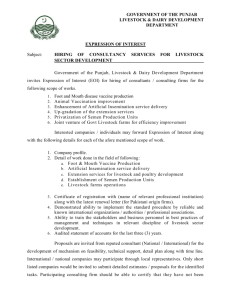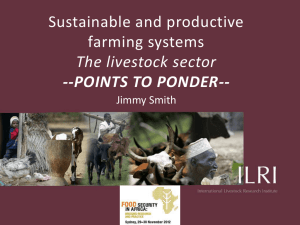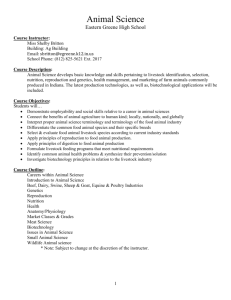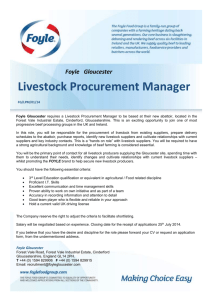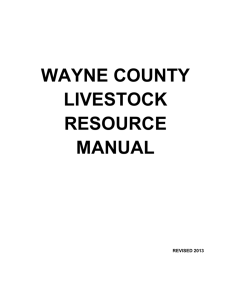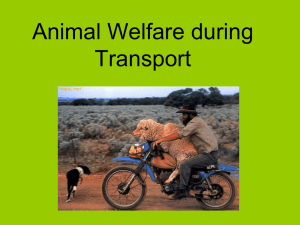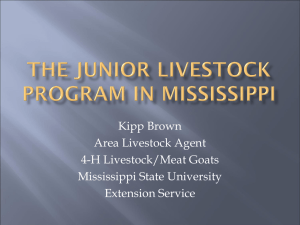Teaching Program Task 3 – Primary Industries
advertisement
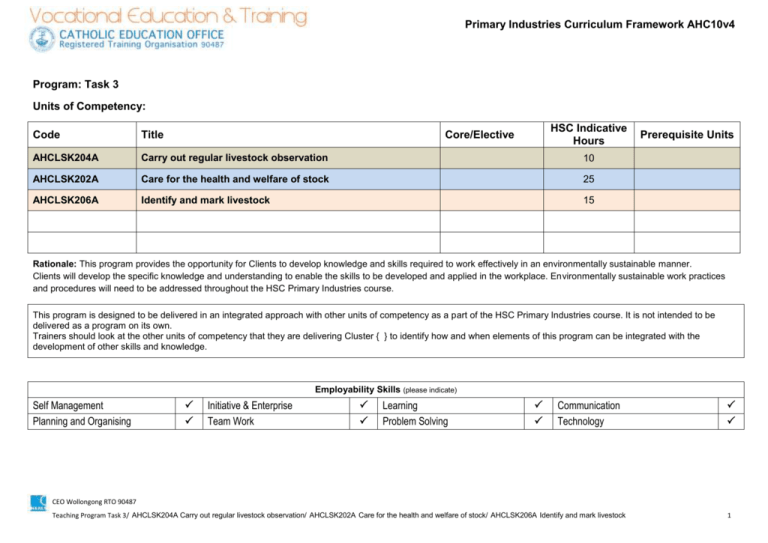
Primary Industries Curriculum Framework AHC10v4
Program: Task 3
Units of Competency:
HSC Indicative
Hours
Code
Title
Core/Elective
AHCLSK204A
Carry out regular livestock observation
10
AHCLSK202A
Care for the health and welfare of stock
25
AHCLSK206A
Identify and mark livestock
15
Prerequisite Units
Rationale: This program provides the opportunity for Clients to develop knowledge and skills required to work effectively in an environmentally sustainable manner.
Clients will develop the specific knowledge and understanding to enable the skills to be developed and applied in the workplace. Environmentally sustainable work practices
and procedures will need to be addressed throughout the HSC Primary Industries course.
This program is designed to be delivered in an integrated approach with other units of competency as a part of the HSC Primary Industries course. It is not intended to be
delivered as a program on its own.
Trainers should look at the other units of competency that they are delivering Cluster { } to identify how and when elements of this program can be integrated with the
development of other skills and knowledge.
Employability Skills (please indicate)
Self Management
Planning and Organising
Initiative & Enterprise
Team Work
Learning
Problem Solving
Communication
Technology
CEO Wollongong RTO 90487
Teaching Program Task 3/ AHCLSK204A Carry out regular livestock observation/ AHCLSK202A Care for the health and welfare of stock/ AHCLSK206A Identify and mark livestock
1
Primary Industries Curriculum Framework AHC10v4
HSC requirements and advice – key terms and concepts:
Carry out regular livestock observation
Care for the health and welfare of stock
Identify and mark livestock
CEO Wollongong RTO 90487
Teaching Program Task 3/ AHCLSK204A Carry out regular livestock observation/ AHCLSK202A Care for the health and welfare of stock/ AHCLSK206A Identify and mark livestock
2
Primary Industries Curriculum Framework AHC10v4
AHCLSK204A Carry out regular livestock observation
Element
Performance
criteria
1.1
1.Prepare to identify and mark animals
Work to be
undertaken is
interpreted from
work program
where necessary,
and confirmed with
management
1.2
Discussions are
held with other
workers who may
be affected by the
activities to ensure
continued smooth
operation of the
process
1.3
Tools and
equipment suitable
for the work to be
undertaken are
selected, checked,
and maintained if
necessary
1.4
Suitable personal
protective
equipment is
selected, used and
maintained.
Range Statement
The range statement relates to
the unit of competency as a
whole.
Content: HSC Requirements and
Advice
Learning
experiences/
Assessment
activities
Resources
Registration/
Signature
and Date
Identifying and marking may include:
tagging
tailing
notching
tattooing
micro-chipping
branding
dehorning
trimming eye teeth
identifying abnormalities or faults and identifying and marking
animals for culling
Livestock may include:
cattle
horses
sheep
pigs
alpacas
goats
deer
Demonstration – correct use
of equipment ,
Correct PPE and work
clothes are worn
Livestock does not include:
horses
Group discussion
Equipment prepared and
checked. Gates are checked
determine identifying and marking methods
PPE stored according to
Industry standard
CEO Wollongong RTO 90487
Teaching Program Task 3/ AHCLSK204A Carry out regular livestock observation/ AHCLSK202A Care for the health and welfare of stock/ AHCLSK206A Identify and mark livestock
3
Primary Industries Curriculum Framework AHC10v4
AHCLSK204A Carry out regular livestock observation
2.
Carry out livestock checks
Element
Performance
criteria
Range Statement
Content: HSC Requirements and
Advice
Learning
experiences/
Assessment
activities
2.1.
. All livestock are
routinely checked for
signs of ill health.
Beef cattle and meat breed
sheep are observed as a
class
2.2.
Livestock are
examined for signs of
illness, injuries and
abnormalities, and
signs of these are
reported in the
methods prescribed in
the organisations work
procedures.
Stock health is checked
under teacher direction
2.3.
While handling
livestock, the potential
for Occupational
Health and Safety
(OHS) hazards is
continually monitored,
risks assessed, and
suitable controls
implemented.
Risk assessment is
completed
2.4.
Livestock are handled
safely and all required
restraints are within
the organisations and
industry guidelines for
animal health and
welfare.
Animal welfare guidleines
are discussed and observed
Resources
Registration/
Signature
and Date
CEO Wollongong RTO 90487
Teaching Program Task 3/ AHCLSK204A Carry out regular livestock observation/ AHCLSK202A Care for the health and welfare of stock/ AHCLSK206A Identify and mark livestock
4
Primary Industries Curriculum Framework AHC10v4
AHCLSK204A Carry out regular livestock observation
Element
Performance
criteria
3.
Deal with livestock emergencies
3.1.
Common signs of
livestock injury or
life threatening
conditions are
detected and the
situation quickly
analysed before
notification or action
is taken.
Range Statement
Content: HSC Requirements and
Advice
Learning
experiences/
Assessment
activities
Resources
Registration/
Signature
and Date
Class notes- dealing with
emergency procedures
3.2.
Life threatening
livestock ailments
requiring emergency
treatment are
notified to the
supervisor, manager
or veterinarian and
immediate
assistance is called.
3.3.
Basic emergency
and/or livestock first
aid procedures are
carried out until
professional help
arrives.
3.4.
Serious cuts and
abrasions to
livestock are
promptly reported to
the supervisor or to
the veterinarian and
assistance provided
as required during
professional
treatment.
Animal health procedures
carried out eg Pink eye
CEO Wollongong RTO 90487
Teaching Program Task 3/ AHCLSK204A Carry out regular livestock observation/ AHCLSK202A Care for the health and welfare of stock/ AHCLSK206A Identify and mark livestock
5
Primary Industries Curriculum Framework AHC10v4
AHCLSK204A Carry out regular livestock observation
4.
Provide veterinary procedure support
Element
Performance
criteria
Range Statement
Content: HSC Requirements and
Advice
Learning
experiences/
Assessment
activities
4.1.
Cuts, abrasions and
bruises are treated
under instruction
from the
veterinarian,
manager or
foreman.
General health care is
carried out
4.2.
Animals are
examined for signs
of distress or
soreness after
moving or mating
procedures and all
abnormalities are
reported.
Class farm visit –
documentation of livestock
health procedures
Resources
Registration/
Signature
and Date
4.3.
Appropriate
treatment is applied
as instructed by the
manager or
supervisor.
CEO Wollongong RTO 90487
Teaching Program Task 3/ AHCLSK204A Carry out regular livestock observation/ AHCLSK202A Care for the health and welfare of stock/ AHCLSK206A Identify and mark livestock
6
Primary Industries Curriculum Framework AHC10v4
AHCLSK202A Care for the health and welfare of stock
Element
Performance
criteria
1. Monitor and assess livestock health and welfare
1.1
Regular checks are
taken to assess
livestock health and
welfare according to
the requirements of
the organisation.
Range Statement
The range statement relates to the
unit of competency as a whole.
Livestock may include:
beef cattle
dairy cattle
sheep
goats
alpacas
Content: HSC Requirements and
Advice
Learning
experiences/
Assessment
activities
Resources
Registration/
Signature
and Date
identification
•
broad knowledge of classification methods used to
identify livestock: – breed
production type
identification system
•
methods and techniques to identify livestock
•
purpose and importance of accurate livestock
identification
1.2.
Symptoms of ill
health and common
diseases, disorders
or parasite
infestations are
recognised and
reported.
behavior
•importance of observing livestock behaviour when undertaking
work tasks
•recognise behavioural characteristics of livestock: –normal
– abnormal
–
changed
•common signs of fear and aggression in livestock and
appropriate responses to these behaviour
1.3.
Livestock are
handled calmly and
according to
enterprise
procedures.
handling
•principles and procedures for handling livestock:
-reducing stress and discomfort
-minimising risk to livestock, self and others
•techniques and methods used to handle livestock:
– move,draft ,control inspect,restrain
•an understanding of the relationship between livestock health
and nutrition
•livestock diet and nutritional requirements
•feeding of livestock: – systems:
a) intensive
b) extensive
– elements
a)
types of feed
b)
feed supplements
c)
water:supply,quanity,quality
-safe feed supply:
a)
hygiene
b) toxic/noxious plants
c) contaminants
CEO Wollongong RTO 90487
Teaching Program Task 3/ AHCLSK204A Carry out regular livestock observation/ AHCLSK202A Care for the health and welfare of stock/ AHCLSK206A Identify and mark livestock
7
Primary Industries Curriculum Framework AHC10v4
AHCLSK202A Care for the health and welfare of stock
Element
Performance
criteria
Range Statement
Content: HSC Requirements and
Advice
Learning
experiences/
Assessment
activities
Resources
Registration/
Signature
and Date
2.
Implement livestock health and
welfare procedures
•an understanding of the relationship between livestock health
and nutrition
•livestock diet and nutritional requirements
•feeding of livestock: – systems:
c) intensive
d) extensive
– elements
d)
types of feed
e)
feed supplements
f)
water:
I.
supply
II.
quantity
III.
quality
-safe feed supply:
d)
hygiene
e) toxic/noxious plants
f)
contaminants
2.1.
Occupational Health
and Safety (OHS)
hazards in the
workplace are
recognised and
safety issues
reported according
to enterprise
requirements.
Risk assessment
completed
Industry legislation
research
Care for health and
welfare of livestock –
work booklet
2.2.
Quarantine and
biosecurity
procedures are
maintained as
instructed to
minimise the risks of
disease
introduction.
quarantine and biosecurity
issues and their management:
– -hygiene procedures
– -minimising disease introduction to: humans
– livestock
– -safe and hygienic procedure for dealing with animal
residue and waste: clean up disposal
•
reporting and recording requirements in relation to
CEO Wollongong RTO 90487
Teaching Program Task 3/ AHCLSK204A Carry out regular livestock observation/ AHCLSK202A Care for the health and welfare of stock/ AHCLSK206A Identify and mark livestock
8
Primary Industries Curriculum Framework AHC10v4
AHCLSK202A Care for the health and welfare of stock
Element
Performance
criteria
Content: HSC Requirements and
Advice
animal health and welfare: –
-i health/disease incidence
-livestock losses
– treatment
-handling records
Practical work and work
sheet
health
•
recognise and assess livestock
condition:
– normal
-abnormal
– injuries
Care for health and
welfare of livestock –
work booklet
Resources
Registration/
Signature
and Date
3.
Admi
nister
drenches,
vaccines
and
prescribed
medicines
to livestock
2.
Impleme
nt livestock
health and
welfare
procedures
2.3.
Thorough personal
hygiene practices
are maintained in all
activities associated
with handling
livestock, including
reducing risks from
diseases
transmissible to
humans.
2.4.
Sick or dead
livestock are safely
treated and
humanely
destroyed, if
necessary.
2.5. Environmental
implications
associated with
livestock husbandry
practices are
identified, assessed
and relevant
measures
implemented.
3.1.
Livestock treatment
site and facilities are
prepared to industry
standards in line
with enterprise
requirements.
Range Statement
Learning
experiences/
Assessment
activities
CEO Wollongong RTO 90487
Teaching Program Task 3/ AHCLSK204A Carry out regular livestock observation/ AHCLSK202A Care for the health and welfare of stock/ AHCLSK206A Identify and mark livestock
9
Primary Industries Curriculum Framework AHC10v4
AHCLSK202A Care for the health and welfare of stock
Element
Performance
criteria
4.Prepare, maintain and store animal
health equipment
3.2.
Livestock
treatments are
prepared and
confirmed against
work plan in line
with manufacturer's
specifications and
work plan.
3.3.
Livestock are
mustered safely,
yarded, controlled,
inspected and
identified for
treatment in line
with enterprise
requirements.
4.1.
Equipment and
materials for treating
livestock are
checked for safe
and sound
operation and
confirmed against
work plan.
4.2.
Syringes, needles
and other veterinary
medicine containers
are placed in
allocated disposal
containers, with tips
removed from
needles prior to
disposal.
Range Statement
Content: HSC Requirements and
Advice
•ill health in livestock:
– common diseases and disorders:
a) signs and symptoms
b) mode of transmission
-parasite infestations:
a) signs and symptoms
b) severity
c) resistance
-testing procedures
– prevention and treatment strategies
•health status of livestock:
– assess:
a) physiological
b) health
-issues identified
– monitor:
a) regular checks
b) post-treatment
Learning
experiences/
Assessment
activities
Resources
Registration/
Signature
and Date
Chemical label are read
and work plan
discussed with farm
manager
Industry standards
adhered to as livestock
are mustered and
moved
treatment
•workplace/enterprise procedures for dealing with sick and
dead
livestock
•common treatment procedures to maintain livestock health
and
welfare:
-types of treatments:
a) drenches
b) vaccines:
CEO Wollongong RTO 90487
Teaching Program Task 3/ AHCLSK204A Carry out regular livestock observation/ AHCLSK202A Care for the health and welfare of stock/ AHCLSK206A Identify and mark livestock
10
Primary Industries Curriculum Framework AHC10v4
AHCLSK202A Care for the health and welfare of stock
4.Prepare, maintain and store animal health
equipment
Element
Performance
criteria
4.3.
Equipment,
materials and
facilities used for
treatments are
cleaned, maintained
and stored in line
with manufacturer's
specifications, OHS
and enterprise
requirements
4.4.
Livestock residues
and waste are
disposed of in an
environmentally
responsible
manner in line
Range Statement
Content: HSC Requirements and
Advice
mode of action
- prescribed medicines treatment site and facilities
equipment and materials used in the treatment of
livestock:
a) name and general features
b) selection:
correct for task
manufacturers’ specifications for use
-use/application:
calibration o dosage/rates according to label
legislative requirements
a) safe disposal
b) cleaning
c) maintenance:
faults and malfunctions
reporting and recording
storage
–preparation of treatments –
administering the
treatment –
withholding periods for treated livestock:
a) compliance
b) isolation
c)
monitoring
Learning
experiences/
Assessment
activities
Resources
Registration/
Signature
and Date
Research OHS
enterprise requirements
Research OHS
enterprise requirements
CEO Wollongong RTO 90487
Teaching Program Task 3/ AHCLSK204A Carry out regular livestock observation/ AHCLSK202A Care for the health and welfare of stock/ AHCLSK206A Identify and mark livestock
11
Primary Industries Curriculum Framework AHC10v4
AHCLSK202A Care for the health and welfare of stock
Performance
Element
criteria
Range Statement
Content: HSC Requirements and
Advice
Learning experiences/
Assessment activities
Registration/
Resources
Signature
and Date
5.
Monitor treated livestock and maintain records
5.1.
Livestock are
monitored posttreatment for signs of
treatment
effectiveness.
5.2.
Livestock health and
condition abnormalities
are recognised and
reported in accordance
with enterprise
requirements.
5.3
. Disease information
is reported to the
manager so that
prevention strategies
can be planned and
implemented.
5.4.
Disease incidence,
livestock losses,
and treatments are
recorded
accurately
according to
organisation
practice and
relevant
regulations
5.5.
All records made,
kept and maintained
are clear, accurate,
and follow the
guidelines laid down
by industry and the
organisation.
CEO Wollongong RTO 90487
Teaching Program Task 3/ AHCLSK204A Carry out regular livestock observation/ AHCLSK202A Care for the health and welfare of stock/ AHCLSK206A Identify and mark livestock
12
Primary Industries Curriculum Framework AHC10v4
AHCLSK206A Identify and mark livestock
1.
Prepare to identify and mark animals
Element
Performance
Range Statement
criteria
1.1
Equipment and
materials for
identifying and
marking animals are
selected and
checked for correct
operation according
to manufacturer's
specifications and
enterprise
requirements
1.2
Suitable marking
sites and facilities
are identified and
prepared according
to enterprise
requirements
1.3
Animal preventative
health treatments
are prepared
according to
manufacturer's
specifications and
supervisor's
instructions.
1.4
Hazards to health
and safety are
identified and safety
concerns reported
to supervisor.
The range statement relates to the
unit of competency as a whole.
Livestock may include:
cattle
horses
sheep
pigs
alpacas
goats.
Identifying and marking may
include:
tagging
tailing
notching
tattooing
micro-chipping
branding
dehorning
trimming eye teeth
identifying abnormalities or faults
and identifying and marking
animals for culling.
Content: HSC Requirements and
Advice
Learning experiences/
Assessment activities
Registration/
Resources Signature
and Date
NLIS tags are checked
Correct ear is identified
correct use of tag pliers is
demonstrated
Demonstration – correct
tagging technique, use of
equipment , OHS
Health treatments are
discussed and administered
where necessary
Safety audit conducted
CEO Wollongong RTO 90487
Teaching Program Task 3/ AHCLSK204A Carry out regular livestock observation/ AHCLSK202A Care for the health and welfare of stock/ AHCLSK206A Identify and mark livestock
13
Primary Industries Curriculum Framework AHC10v4
AHCLSK206A Identify and mark livestock
2.
Identify and mark animals
Element
Performance
Range Statement
criteria
2.1
Suitable Personal
Protective Equipment
(PPE) and clothing is
selected, used and
maintained according
to Occupational Health
and Safety (OHS)
requirements.
2.2
. Animals are safely
mustered and young
animals are identified,
drafted and moved to
marking site in
readiness for
identifying and
marking
2.3.
Animal identifying and
marking operations are
safely carried out
according to enterprise
and animal welfare
legislative
requirements.
2.4.Environmental
implications
associated with
identifying and
marking animals are
recognised, assessed
and reported to the
supervisor
Content: HSC Requirements and
Advice
Learning experiences/
Assessment activities
Registration/
Resources Signature
and Date
Environmental audit carried
out
CEO Wollongong RTO 90487
Teaching Program Task 3/ AHCLSK204A Carry out regular livestock observation/ AHCLSK202A Care for the health and welfare of stock/ AHCLSK206A Identify and mark livestock
14
Primary Industries Curriculum Framework AHC10v4
AHCLSK206A Identify and mark livestock
3. Complete identifying and marking operation
Element
Performance
Range Statement
criteria
3.1.
Animal count is
conducted and
accurately recorded
according to
enterprise
requirements.
3.2.
Animals are
prepared and
moved along a
planned route
without damage to
person, livestock,
property or
environment.
3.3.
Identifying and
marking equipment,
materials and
facilities are cleaned
and maintained
according to OHS
and enterprise
requirements.
3.4.
Equipment faults or
malfunctions are
detailed and
reported according
to enterprise
requirements.
3.5.
Animal residues and
waste are disposed
of according to OHS
and enterprise
environmental
practices.
Content: HSC Requirements and
Advice
Learning experiences/
Assessment activities
Registration/
Resources Signature
and Date
Stock are let out of yards and
counted
Stock are moved to required
paddock along designated
route
Post marking equipment
check and procedures are
identified and executed
Necessary records are
completed
Yard residues are removed
and disposed of appropriately
CEO Wollongong RTO 90487
Teaching Program Task 3/ AHCLSK204A Carry out regular livestock observation/ AHCLSK202A Care for the health and welfare of stock/ AHCLSK206A Identify and mark livestock
15

